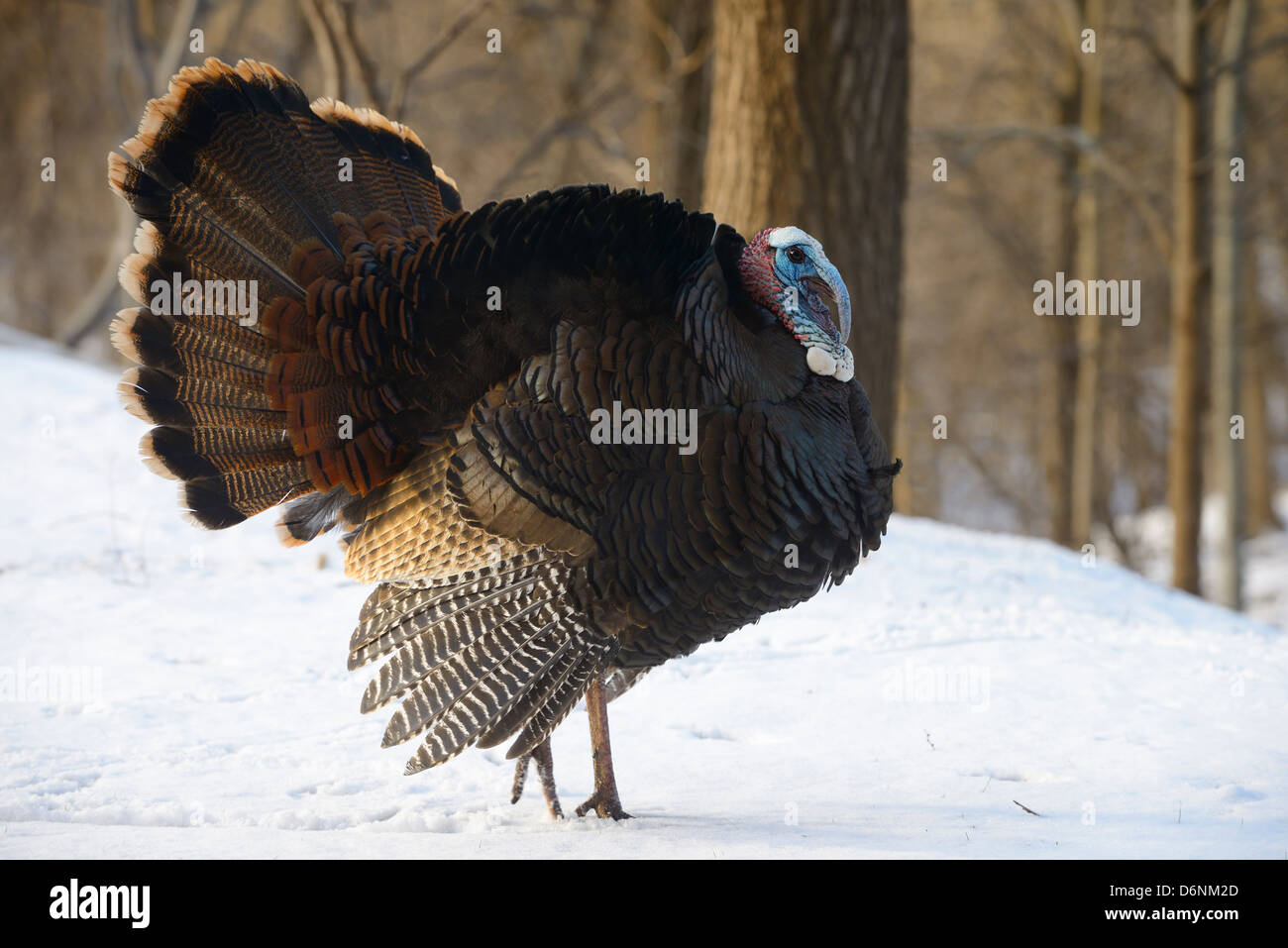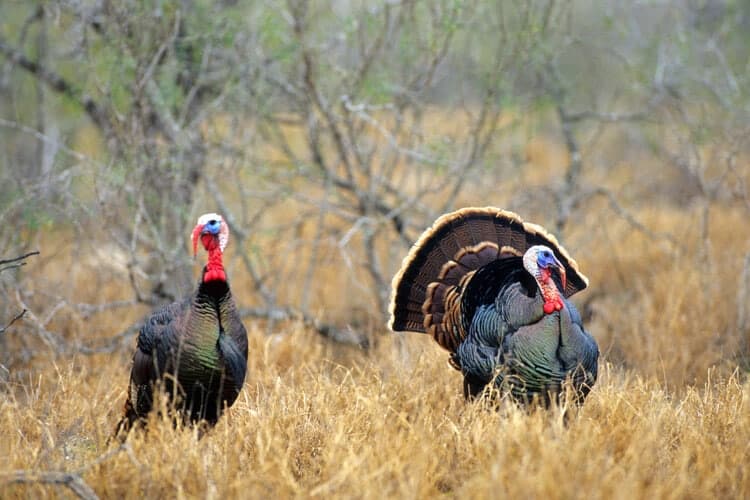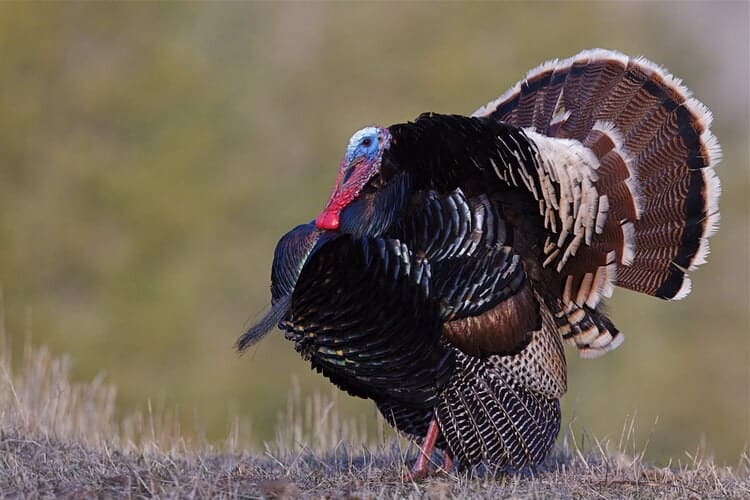Have you heard the phrase “strut your stuff”? It means to show off what you’re good at by doing it with pride and confidence. What does that have to do with turkeys? “Strutting” is the word for when a turkey puffs up its feathers. This is what makes this bird go from bland to grand.
Indeed, turkeys exhibit this fascinating behavior to attract mates, show their dominance, or defend against predators. Let’s look at each of these reasons in more detail.
As turkey hunters know, a tom’s behavior can reveal a lot about his mood and mindset. Unlike deer or elk, turkeys are vocal birds that use diverse visual displays to communicate. Learning to read their body language is key to successful hunting. One prominent signal is when a male puffs up his feathers. But what exactly does this mean?
Why Do Gobblers Puff Up?
For wild turkeys, puffing up feathers is a way to make themselves look bigger and attract attention. Males puff up and fan out for several key reasons
-
Dominance Displays – Establishing pecking order in the flock hierarchy The more dominant bird looks the biggest
-
Courting Hens – Trying to catch a female’s eye during the breeding season.
-
Marking Territory – Warding off rival males from their zone of dominance.
-
Responding to Calls – Reacting to perceived challengers or receptive hens.
-
Alarm/Agitation – Signaling distress if a major threat appears suddenly.
When Do Toms Puff Their Feathers?
Male turkeys mostly puff up and display during the spring breeding season. But they also do it year-round in certain situations:
- Strutting and fanning for hens
- Battling with other males
- Reacting to hunter calls
- Establishing flock hierarchy
- Defending territory from intruders
- Warding off predators
- Displaying alarm if suddenly startled
In general, expect a puffed-up tom any time males are jockeying for position in the pecking order.
What Does Puffing Up Look Like?
When a gobbler puffs up, here’s what you’ll see:
- Feathers ruffled outward to appear larger
- Tail fanned upright and spread wide
- Wings slightly dropped and angled out
- Chest thrust outward
- Head and neck extended upward
- Gobbling and spitting sounds
- Strutting in semicircles
His silhouette will be very round and wide rather than slender when puffed up.
Reading Puffing Behavior in the Field
Now let’s apply this knowledge in real hunting scenarios:
-
A puffed-up, strutting tom is likely looking for hens or responding to calls. Get ready!
-
Two puffed up males facing off signals a dominance battle – the herd boss is being challenged.
-
A puffed up tom wandering and gobbling is marking his territory. He feels secure.
-
Sudden puffing without strutting means he’s alarmed by danger like your footsteps. Back off!
-
Puffing and rapid putting indicates agitation at something unusual. He may flee soon.
Using Decoys and Calling to Your Advantage
Knowing a tom puffs up when responding to perceived challengers, you can use calling and decoys to your advantage:
-
Start with light calling to mimic an intruder and provoke puffing up.
-
Once puffed up, get his attention with aggressive fighting purrs or excited yelps.
-
Present a dominant strutting decoy to stoke his interest and competitive reaction.
-
Coax him into range with your calls while he’s focused on the “rival” decoy.
In Summary
When you spot a male wild turkey puffing up his plumage, it signals something has grabbed his attention or provoked a reaction. By learning this body language, hunters can better predict gobbler behavior during the thrilling spring season. Analyzing when and why toms puff up gives you an edge in calling, positioning, and decoy setup. Master reading turkey body language, and your hunting success is sure to soar.

The 3 Reasons Turkeys May Puff Up

In general, strutting is associated with the breeding season: male turkeys inflate their feathers and spark their colors to wow females. This is not, however, an atypical behavior in the animal world; many male birds seem to be more favored by nature than females. Indeed, males generally sport a more shimmering and flamboyant plumage than females and also possess other characteristics that allow them to impress their female counterparts. This flamboyant manifestation of virility always has the same goal, that of attracting a female to lead to eventual mating.
Moreover, in the case of turkeys, it is not only mature males who have the ability to strut: optimistic young gobblers may also strut around in the presence of hens in the vain hope of stimulating a breeding session.
What Are the Characteristics of the Strut?

You may have seen pictures of turkeys strutting around, or you may have seen them do this many times while hunting in the wild. In any case, here is a small summary of the characteristics of strutting:
- The turkey first lowers its main feathers until they touch the ground.
- Then she forms a fan with her tail.
- She stands all of the feathers on her back and chest up straight.
- She lowers her head and neck in an “S” shape.
Additionally, at the base of each feather are small muscles that allow turkeys to move their feathers. These muscles are connected to other very small muscles in the skin. So, when a turkey struts, she contracts the muscles that control the position of the feathers, causing the body’s feathers to stand up.
The turkey is now ready to impress females or intimidate rivals!
What does it mean when a turkey puffs up?
FAQ
Why do turkeys make a puffing sound?
How can you tell if a turkey is happy?
Do girl turkeys puff up?
Why do turkeys puff up?
Be it pet or wild, the puffing up which is also known as strut behavior has commonly been witnessed among turkeys. And predominately this behavior is manifested by a male turkey. Male turkeys puff up their feathers while pulling their wings and fan the tails exhibiting colorful long features to entice female turkeys for mating.
Why do male turkeys puff up their feathers?
Male turkeys puff up their feathers while pulling their wings and fan the tails exhibiting colorful long features to entice female turkeys for mating. Male turkeys display this puffing up or mating dance mostly during the period of breeding so that the female turkeys turn their head over heels towards the male turkeys for mating.
How do you know if a Turkey is puffing up?
The first sign that can help you identify puff up in turkeys is that noticing the turkeys drop their wings in the first place to touch ground. Another sign of recognizing puffing up in turkeys is that catching a glimpse of holding the feathers of their tail in a vertical position.
Why do Hen turkeys strut their feathers?
A few hunters have observed hen turkeys strut their feathers too, but that is a rare occurrence. It is usually a response to another aggressive hen or any other strong stimulus. A predator threatening a brood of chicks can be a reason.
How do you know if a Turkey is a gobbler?
The bird will hold its tail in a vertical position and spread its tail feathers to form a fan. The gobbler will place all the back and breast feathers in an erect position, making him appear larger. The head, naked skin and caruncles of a wild turkey may range from blue to bright red or flesh tone. The bird’s crown is usually pure white.
How do you know if a Turkey is aggravated?
Reading the turkey’s body language right can be a great advantage for a hunter in such scenarios. In my experience, the twitching of the wings is one sign that indicates that the bird is aggravated. The other obvious sign is the change in head coloration. If the head color is white, light red, or blue, the bird is relaxed.
